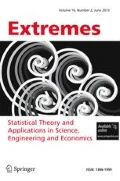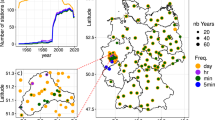Abstract
Large, non-stationary spatio-temporal data are ubiquitous in modern statistical applications, and the modeling of spatio-temporal extremes is crucial for assessing risks in environmental sciences among others. While the modeling of extremes is challenging in itself, the prediction of rare events at unobserved spatial locations and time points is even more difficult. In this Editorial, we describe the data competition that was organized for the 11th international conference on Extreme-Value Analysis (EVA 2019), for which several teams modeled and predicted Red Sea surface temperature extremes over space and time. After introducing the dataset and the goal of the competition, we disclose the final ranking of the teams, and we finally discuss some interesting outcomes and future challenges.
Similar content being viewed by others
References
Cantin, N.E., Cohen, A.L., Karnauskas, K.B., Tarrant, A.M., McCorkle, D.C.: Ocean warming slows coral growth in the central Red Sea. Science 329(5989), 322–325 (2010)
Castro-Camilo, D, Huser, R: Local likelihood estimation of complex tail dependence structures, applied to U.S. precipitation extremes. Journal of the American Statistical Association To appear (2019)
Castruccio, S., Huser, R., Genton, M.G.: High-order composite likelihood inference for max-stable distributions and processes. J. Comput. Graph. Stat. 25, 1212–1229 (2016)
Chaidez, V., Dreano, D., Agusti, S., Duarte, C.M., Hoteit, I.: Decadal trends in Red Sea maximum surface temperature. Sci. Rep. 7(8144), 1–8 (2017)
Davison, A.C., Padoan, S.A., Ribatet, M.: Statistical modelling of spatial extremes (with Discussion). Stat. Sci. 27(2), 161–186 (2012)
Davison, A.C., Huser, R., Thibaud, E.: Spatial extremes. In: Gelfand, A.E., Fuentes, M, Smith, R.L. (eds.) Handbook of Environmental and Ecological Statistics, pp 711–744. CRC Press (2019)
Donlon, C.J., Martin, M., Stark, J., Roberts-Jones, J., Fiedler, E., Wimmer, W.: The operational sea surface temperature and sea ice analysis (OSTIA) system. Remote Sens. Environ. 116, 140–158 (2012)
Engelke, S., Malinowski, A., Kabluchko, Z., Schlather, M.: Estimation of Huesler–Reiss distributions and Brown–Resnick processes. J. R. Stati. Soc.: Series B (Stat. Methodol.) 77(1), 239–265 (2015)
de Fondeville, R., Davison, A.C.: High-dimensional peaks-over-threshold inference. Biometrika 105(3), 575–592 (2018)
Gneiting, T., Raftery, A.E.: Scritly proper scoring rules, prediction, and estimation. J. Am. Stat. Assoc. 102(477), 359–378 (2007)
Gneiting, T., Ranjan, R.: Comparing density forecasts using threshold- and quantile-weighted scoring rules. J. Bus. Econ. Stat. 29(3), 411–422 (2011)
Hazra, A., Huser, R: A low-rank semiparametric Bayesian spatial model for estimating extreme Red Sea surface temperature hotspots. arXiv:1912.05657 (2019)
Hazra, A., Reich, B.J., Shaby, B.A., Staicu, A.: A semiparametric Bayesian model for spatiotemporal extremes. arXiv:1812.11699 (2019)
Huser, R., Davison, A.C.: Space-time modelling of extreme events. J. R. Stat. Soc.: Series B (Stat. Methodol.) 76(2), 439–461 (2014)
Huser, R., Genton, M.G.: Non-stationary dependence structures for spatial extremes. J. Agric. Biol. Environ. Stat.s 21(3), 470–491 (2016)
Huser, R., Wadsworth, J.L.: Modeling spatial processes with unknown extremal dependence class. J. Am. Stat. Assoc. 114, 434–444 (2019)
Huser, R., Opitz, T., Thibaud, E.: Bridging asymptotic independence and dependence in spatial extremes using Gaussian scale mixtures. Spatial Stat. 21, 166–186 (2017)
Huser, R., Dombry, C., Ribatet, M., Genton, M.G.: Full likelihood inference for max-stable data. Stat 8, e218 (2019)
Lerch, S., Thorarinsdottir, T.L.: Comparison of non-homogeneous regression models for probabilistic wind speed forecasting. Tellus A: Dyn. Meteorol. Oceanogr. 65(1), 21206 (2013)
Lerch, S., Thorarinsdottir, T.L., Ravazzolo, F., Gneiting, T.: Forecaster’s dilemma: Extreme events and forecast evaluation. Stat. Sci. 32(1), 106–127 (2017)
McClanahan, T.R., Ateweberhan, M., Muhando, C.A., Maina, J., Mohammed, M.S.: Effects of climate and seawater temperature variation on coral bleaching and mortality. Ecol. Monogr. 77(4), 503–525 (2007)
Morris, S.A., Reich, B.J., Thibaud, E., Cooley, D.: A space-time skew-t model for threshold exceedances. Biometrics 73(3), 749–758 (2017)
Oesting, M., Schlather, M., Friederichs, P.: Statistical post-processing of forecasts for extremes using bivariate Brown-Resnick processes with an application to wind gusts. Extremes 20(2), 309–332 (2017)
Opitz, T.: Extremal t processes: Elliptical domain of attraction and a spectral representation. J. Multivar. Anal. 122(1), 409–413 (2013)
Opitz, T., Huser, R., Bakka, H., Rue, H.: INLA goes extreme: Bayesian tail regression for the estimation of high spatio-temporal quantiles. Extremes 21(3), 441–462 (2018)
Padoan, S.A., Ribatet, M., Sisson, S.A.: Likelihood-based inference for max-stable processes. J. Am. Stat. Assoc. 105(489), 263–277 (2010)
Reich, B.J., Shaby, B.A.: A hierarchical max-stable spatial model for extreme precipitation. Ann. Appl. Stat. 6(4), 1430–1451 (2012)
Vettori, S., Huser, R., Genton, M.G.: Bayesian modeling of air pollution extremes using nested multivariate max-stable processes. Biometrics 75, 831–841 (2019)
Wadsworth, J.L., Tawn, J.A.: Dependence modelling for spatial extremes. Biometrika 99(2), 253–272 (2012)
Wadsworth, J.L., Tawn, J.A.: Efficient inference for spatial extreme value processes associated to log-Gaussian random functions. Biometrika 101(1), 1–15 (2014)
Wintenberger, O.: Editorial: Special issue on the extreme value analysis conference challenge “prediction of extremal precipitation”. Extremes 21(3), 425–429 (2018)
Yu, H., Uy, W.I.T., Dauwels, J.: Modeling spatial extremes via ensemble-of-trees of pairwise copulas. IEEE Trans. Signal Process. 65(3), 571–586 (2017)
Acknowledgements
I would like to thank Bojan Basrak, Hrvoje Planinic and the whole EVA 2019 conference local and scientific committees, for organizing such a successful conference. I also thank Olivier Wintenberger, Alec Stephenson, Holger Rootzén and Thomas Mikosch for their support, as well as for helpful discussions and advice on the data competition, and for providing feedback on an early draft of this Editorial. Finally, I thank and congratulate all teams, without whose active and positive participation this competition would not have taken place.
Author information
Authors and Affiliations
Corresponding author
Additional information
Publisher’s note
Springer Nature remains neutral with regard to jurisdictional claims in published maps and institutional affiliations.
This publication is based upon work supported by the King Abdullah University of Science and Technology (KAUST) Office of Sponsored Research (OSR) under Award No. OSR-CRG2017-3434.
Rights and permissions
About this article
Cite this article
Huser, R. Editorial: EVA 2019 data competition on spatio-temporal prediction of Red Sea surface temperature extremes. Extremes 24, 91–104 (2021). https://doi.org/10.1007/s10687-019-00369-9
Received:
Revised:
Accepted:
Published:
Issue Date:
DOI: https://doi.org/10.1007/s10687-019-00369-9
Keywords
- Data competition
- EVA 2019 Conference
- Extremal dependence
- Extreme event
- Prediction
- Red Sea surface temperature data
- Spatio-temporal process
- Threshold-weighted continuous ranked probability score




